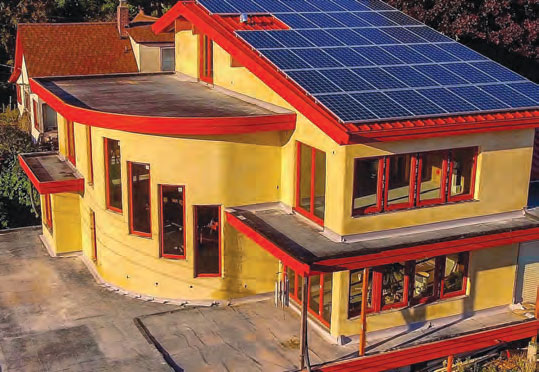Pulteney Street SurveySpring 2020

Buildings of the Future
by Andrew Wickenden '09
From a field of nearly 20,000 applications, Matthew Mead '13 and his business partner, Tommy Gibbons, were selected for Forbes' 2020 "30 Under 30" list for "creating the products, methods and materials of tomorrow."
As he studied architecture and environmental studies at HWS, Matthew Mead '13 had a growing sense that the relationship between the human-made environment and the natural world was unsustainable.
"The built environment is responsible for nearly 40% of our domestic energy consumption and carbon footprint," says Mead. "If we don't change the way we design and operate our built environment, we don't really have a chance of mitigating the environmental impacts of the built world."
With Hempitecture, Mead is now at the forefront of a green building revolution. Offering materials like hempcrete and HempWool, the company is reimagining design and construction with sustainable alternatives to common products and practices.
The idea began with Mead's senior thesis, which analyzed natural building techniques and strategies and revealed that hemp-based products are not only qualitatively comparable but "non-toxic, environmentally friendly and fireproof," he says.
Seeing the potential for hempcrete in the U.S., Mead developed a business plan and entered the Colleges' 2013 Pitch Contest for student entrepreneurs. Under the guidance of Pitch mentor Ira Goldschmidt '77, Mead and Tyler Mauri '13 took Hempitecture to the finals of that year's competition.
In the months that followed, however, social stigma and legal strictures around hemp - part of the cannabis genus, which includes marijuana - proved challenging, from sourcing materials to securing financing and banking access to selling the viability of hemp-based building materials. Despite top-three finishes at other entrepreneurial competitions, Mead recalls skepticism of his vision.

Hempitecture was brought on board in 2017 at
the Highland Hemp House project, the undertaking
of a homeowner determined to take advantage of
the sustainable and climate-friendly properties of
hempcrete in the renovation of her 1969 house
in Bellingham, Wash.
Although hemp does not contain appreciable levels of THC, the psychoactive compound in marijuana, Mead remembers hearing jokes "about the whole neighborhood wanting the hemp house to burn down so they could catch a buzz. Of course our building material is fireproof, and they clearly missed that part of my presentation."
After graduation, Mead worked in St. John in the Caribbean at an eco-resort, where he had interned as a student and for the first time "connected with a passion of creating and making in the real world." He developed carpentry skills and refined his approach to green design and construction, building sustainable, off-grid, solar-powered eco-cottages - until a social media post about his Pitch presentation reached an Idaho project manager who invited Mead to put Hempitecture's principles into practice.
That year, Mead and Mauri moved to Idaho to begin a unique design-build project that ultimately became the country's first public-use building made of hempcrete. Today, the building houses Idaho Basecamp, a nonprofit organization connecting adults and young people to nature and one another through adventure education experiences. Mead, who serves on the organization's board of directors, says that project "may still be one of my proudest moments, as there was so much we had to work through to make it possible."
In 2018, Mead was joined by his former high school classmate Tommy Gibbons to scale Hempitecture into a company capable of impacting every hempcrete project in the U.S.
"I liken the journey of Hempitecture to a valuable lesson I learned as an architecture student at HWS: process is everything," Mead says. "Process gets you from an idea to an end result, and our process is continually evolving."
Now based in Ketchum, Idaho, where Mead serves as a planning and zoning commissioner, Hempitecture offers installation, consulting and design services, as well as building and insulation materials, equipment and training for industry professionals. Collaborating with architects, engineers and developers, the company works to create habitats beneficial both to those who use them and to the environment itself.
Reflecting on Hempitecture's journey, Mead says that HWS faculty and staff - including Associate Professor Kirin Makker, Professor Phillia Yi and Centennial Center Director Amy Forbes - went "above and beyond - because they believed in me and the Hempitecture concept. It has been very rewarding, albeit a little overwhelming, to receive an honor such as Forbes' "30 Under 30," but there are so many people who actually made it possible, and this can be traced right back to my time at HWS."
